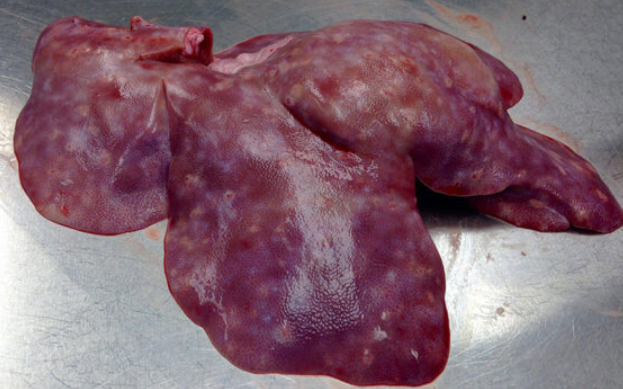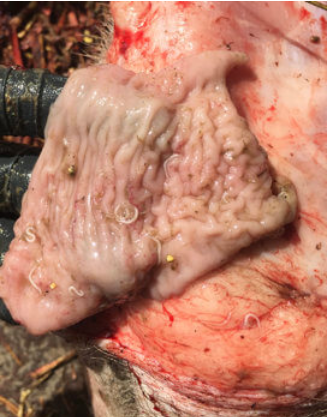



Parasites persist in hog production, especially in niche markets
Environmentally controlled hog facilities eliminated most swine parasites. But Ascaris suum (roundworm) continues to persevere on some conventional farms and frequently on farms for niche markets.
“Bringing pigs indoors onto slatted floors has decreased the overall prevalence of parasites in swine,” reported Laura Carroll, DVM, Four Star Veterinary Service in Elizabethtown, Pennsylvania. “But roundworms can still be a problem in conventional swine units.
“Niche production systems where pigs are raised on pasture or on solid floors with bedding are more prone to developing parasitic infections,” she said. In addition to roundworm, these farms can also face issues with Trichuris suis (whipworm).
Roundworm encounters
Roundworms continue to persist in hog systems because they are difficult to eliminate with common sanitation methods, Carroll explained. The adult female can lay up to 2 million eggs a day — eggs that are resistant to disinfectants and chemicals.

The clinical signs of roundworms may include a cough that is non-responsive to antibiotics, thumping, unthriftiness, poor hair coat, decreased growth rates and presence of adult worms in feces. On necropsy, the most prevalent lesions are milk spots on the liver due to larval migration of worms and detection of adult worms in the small intestine.
“Roundworms can cause decreased growth rates and feed efficiency, and increased mortality — particularly in younger animals,” Carroll said. “They can also cause liver condemnation and decreased carcass value at slaughter plants.”
Roundworm treatment
Carroll recommends routine monitoring for roundworm on all sow farms, both conventional and niche. Roundworm eggs can be detected either in fecal samples or oral fluids.
“In our niche production systems, we detect roundworm eggs in probably 75% of the samples,” she added.
“Depending on the severity of the infection and management goals, we may implement a mass herd deworming program or manage with a strategic control program at critical time points based on prepatent period of the worm and type of anthelmintic used.
“At the sow farm level, this could entail administering an anthelmintic to gilts just prior to introduction into the sow herd and deworming sows 2 to 3 weeks prior to farrowing,” Carroll explained. “Sows can transmit roundworms to their piglets…deworming sows a couple of weeks before farrowing prevents them from contaminating their pigs.”
Several anthelmintic products are available for roundworm treatment and control. Carroll recommends working with a veterinarian to determine which one is most appropriate for their herd.
“Anthelmintics can vary in their spectrum of activity,” she explained. “Some are effective at eliminating the mature (adult) worms but not effective against immature worms. Depending on what’s going on at your farm, one product may be preferred over another. If the appropriate product is used and it is administered at the correct timing interval, then generally we have a good response to treatment.”
In addition, increased sanitation and washing sows pre-farrow to remove feces will help reduce the number of roundworm eggs in the environment which may subsequently infect piglets.
Whipworm issues
Niche production systems also are more prone to whipworms than other hog systems, Carroll said. These parasites are more difficult to detect because females are sporadic egg layers. Infected pigs may not be passing eggs when a fecal sample is taken.

The clinical signs are more obvious than roundworms. Young pigs will have mucohemorrhagic diarrhea and exhibit signs of wasting and lethargy; there will also be increased mortality. Diagnosis on necropsy is the presence of worms in the large intestine and cecum.
“If whipworm eggs are found, we implement treatment with an anthelmintic that’s effective,” she said. “There are less products effective against whipworms than roundworms. So it’s important to discuss with your veterinarian what’s effective.
“We also work hard to clean up the facility as much as possible. Disinfect between groups, but it is still difficult to control because the eggs are very persistent in the environment.” The eggs can remain viable for several years in favorable conditions.
“Control can be challenging based on the facility design, solid floor, pastures,” she added. “We do pasture rotation to minimize how many worms are shed into the environment.”
In herds where whipworms are established, Carroll uses an anthelmintic as a preventative to keep whipworm levels lows. All new groups of pigs added to the herd are treated.
“Prevention is the key to parasite control,” she said. “This goes back to having a good relationship with your veterinarian and making sure you have good control programs in place to minimize the transmission and keep the burden level as low as possible.”








